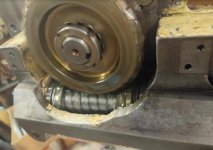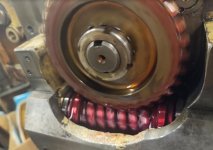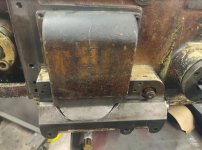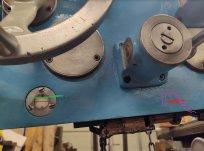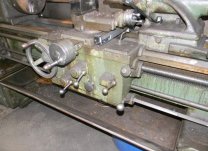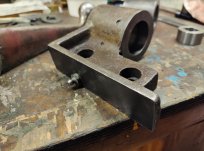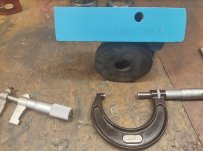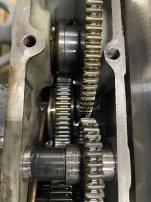texasgeartrain
Titanium
- Joined
- Feb 23, 2016
- Location
- Houston, TX
Test 2:
Well I think I realize what was going on with the pump and oil level. When I first began the first test I was only using the hand wheel, no clutches engaged. Later I engaged both, and raised oil level a little.
Well if you look at the apron, there are two cams that run the pump about here:
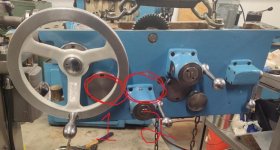
It takes 5 hand wheel turns to rotate cam 1 once, in other words one pump of the oil pump.
Cam two is naturally turned by worm wheel, though not directly on worm wheel's shaft. 2.5 turns of the worm wheel to rotate cam 2 once.
By engaging the lower clutch I can rotate both cams with the hand wheel, but cam two spins much faster. Cam 2 spins one revolution to 1.25 turns of the handwheel.
Anyway, I filled oil the 2nd time, to just a hair over the site glass midway marker. And the pump pumps.
As a follow up to the dirty oil. I filled with new oil and ran about 15-20 running apron by hand. Let it sit a couple hours, and ran it another 20 minutes or so. I drained this second batch of oil also. It was much improved over the first batch, but I could still see some off color to it.
I will fill with new clean oil and roll with it. I'll probably run the machine 6 months to a year, then drop oil and replace the pump filter again. As it is now, I think I'll be in real good shape.
One thing i forgot to mention in the last test was the gits oilers I added to the clutch lever housings. I did that to lube the thrust bearings there. But it has had a side benefit of making the engage/disengage operation real nice, the internal plungers just feel like they're lubed now.

Well I think I realize what was going on with the pump and oil level. When I first began the first test I was only using the hand wheel, no clutches engaged. Later I engaged both, and raised oil level a little.
Well if you look at the apron, there are two cams that run the pump about here:

It takes 5 hand wheel turns to rotate cam 1 once, in other words one pump of the oil pump.
Cam two is naturally turned by worm wheel, though not directly on worm wheel's shaft. 2.5 turns of the worm wheel to rotate cam 2 once.
By engaging the lower clutch I can rotate both cams with the hand wheel, but cam two spins much faster. Cam 2 spins one revolution to 1.25 turns of the handwheel.
Anyway, I filled oil the 2nd time, to just a hair over the site glass midway marker. And the pump pumps.
As a follow up to the dirty oil. I filled with new oil and ran about 15-20 running apron by hand. Let it sit a couple hours, and ran it another 20 minutes or so. I drained this second batch of oil also. It was much improved over the first batch, but I could still see some off color to it.
I will fill with new clean oil and roll with it. I'll probably run the machine 6 months to a year, then drop oil and replace the pump filter again. As it is now, I think I'll be in real good shape.
One thing i forgot to mention in the last test was the gits oilers I added to the clutch lever housings. I did that to lube the thrust bearings there. But it has had a side benefit of making the engage/disengage operation real nice, the internal plungers just feel like they're lubed now.



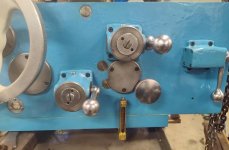

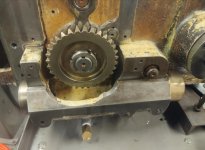
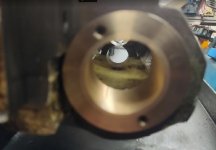
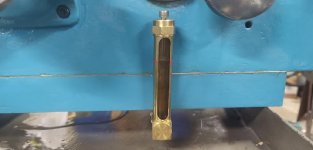
 . At some point later in my life I might make a nice thumb screw to go there.
. At some point later in my life I might make a nice thumb screw to go there.
